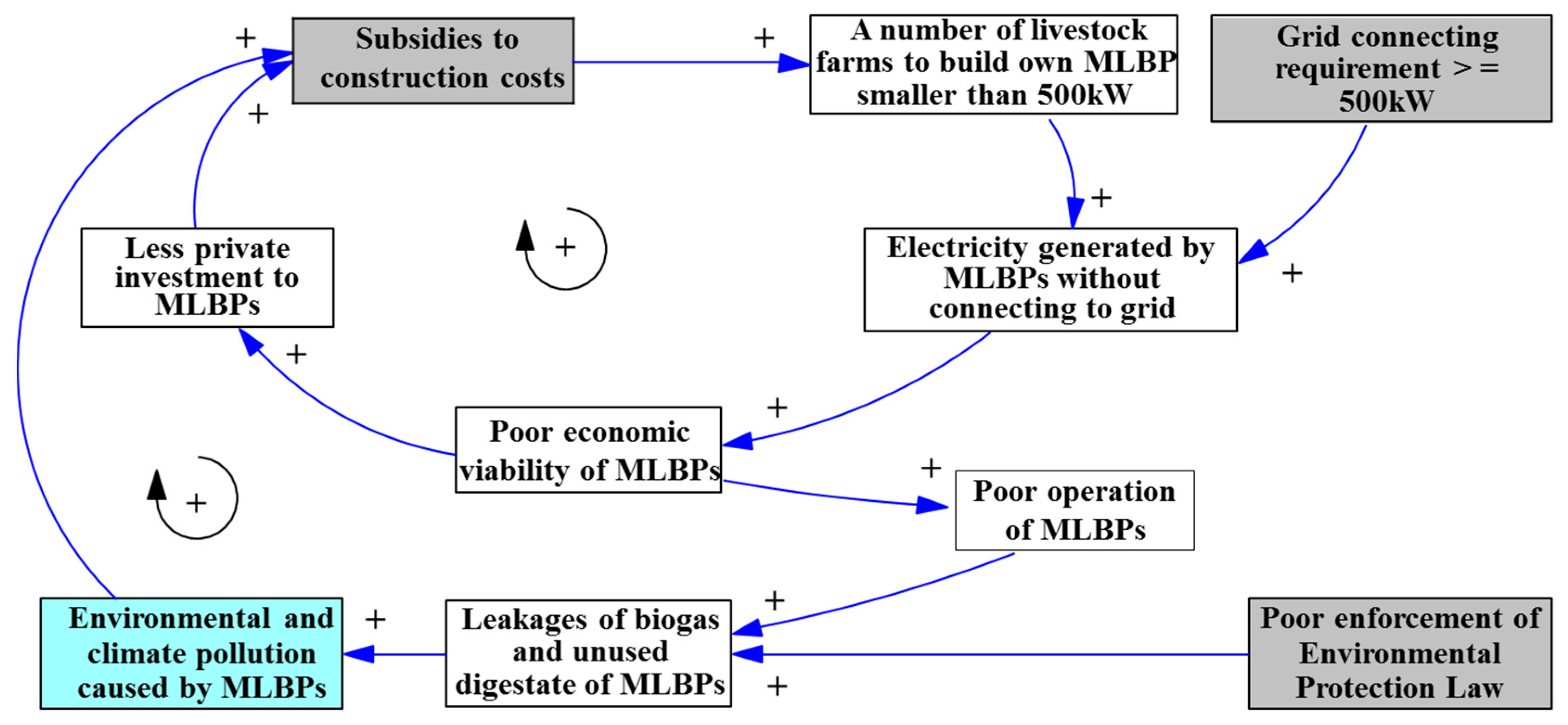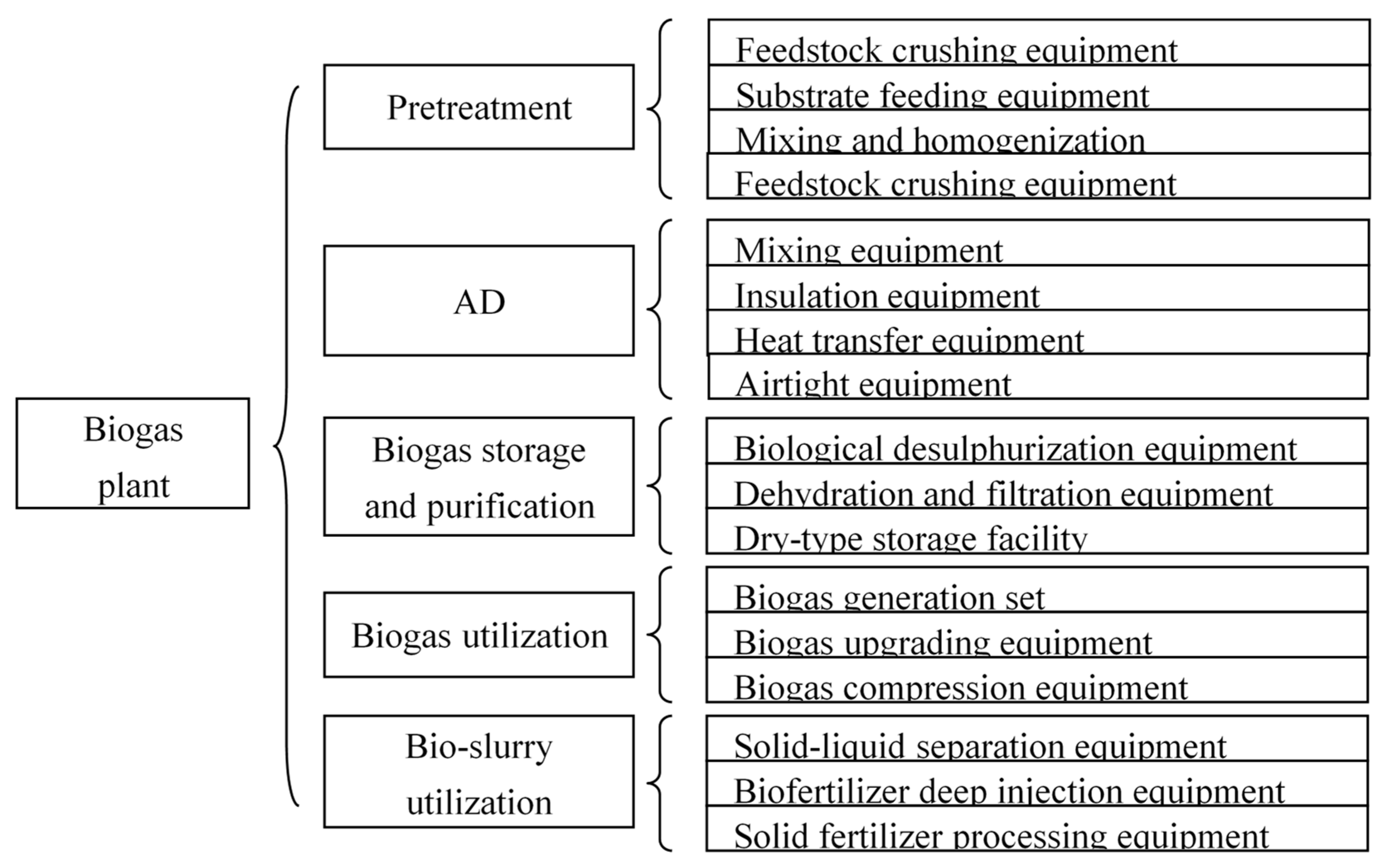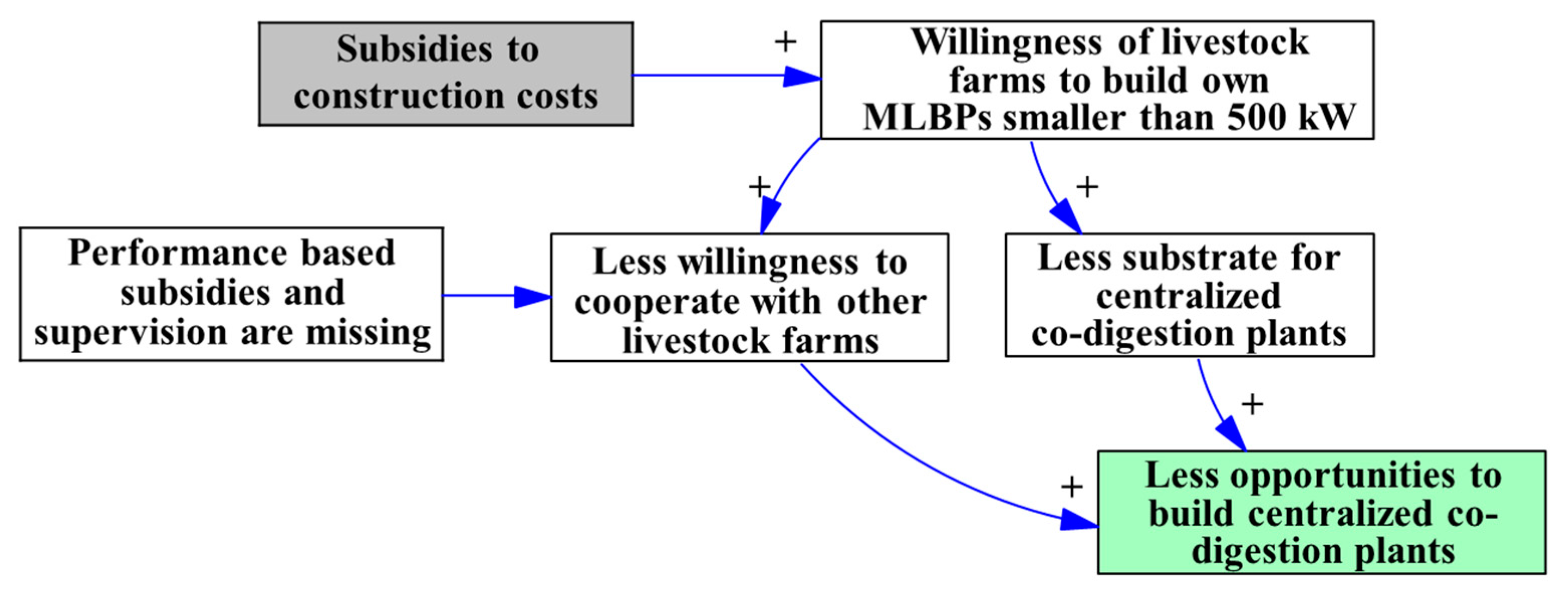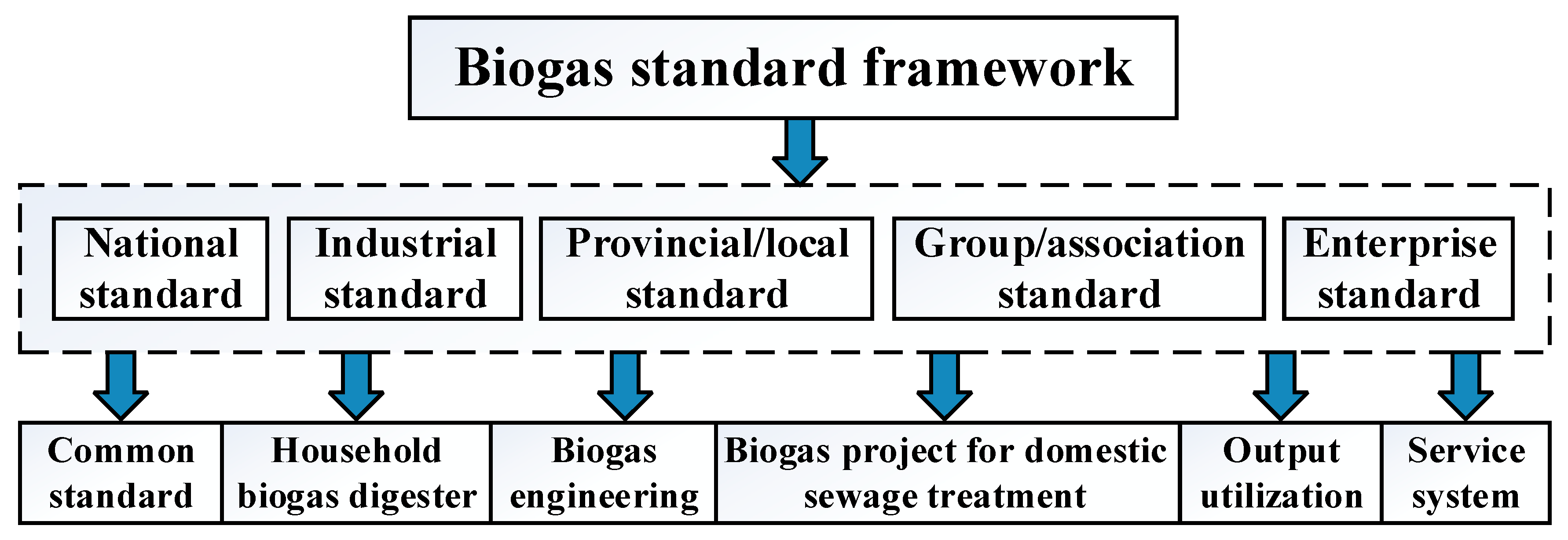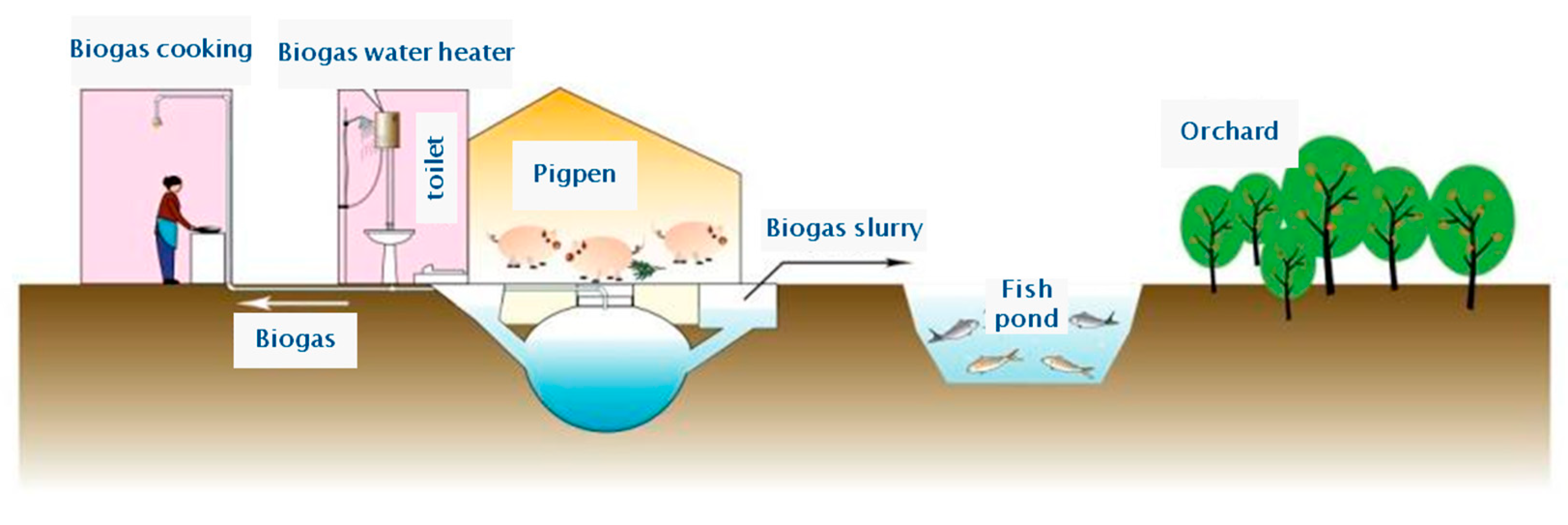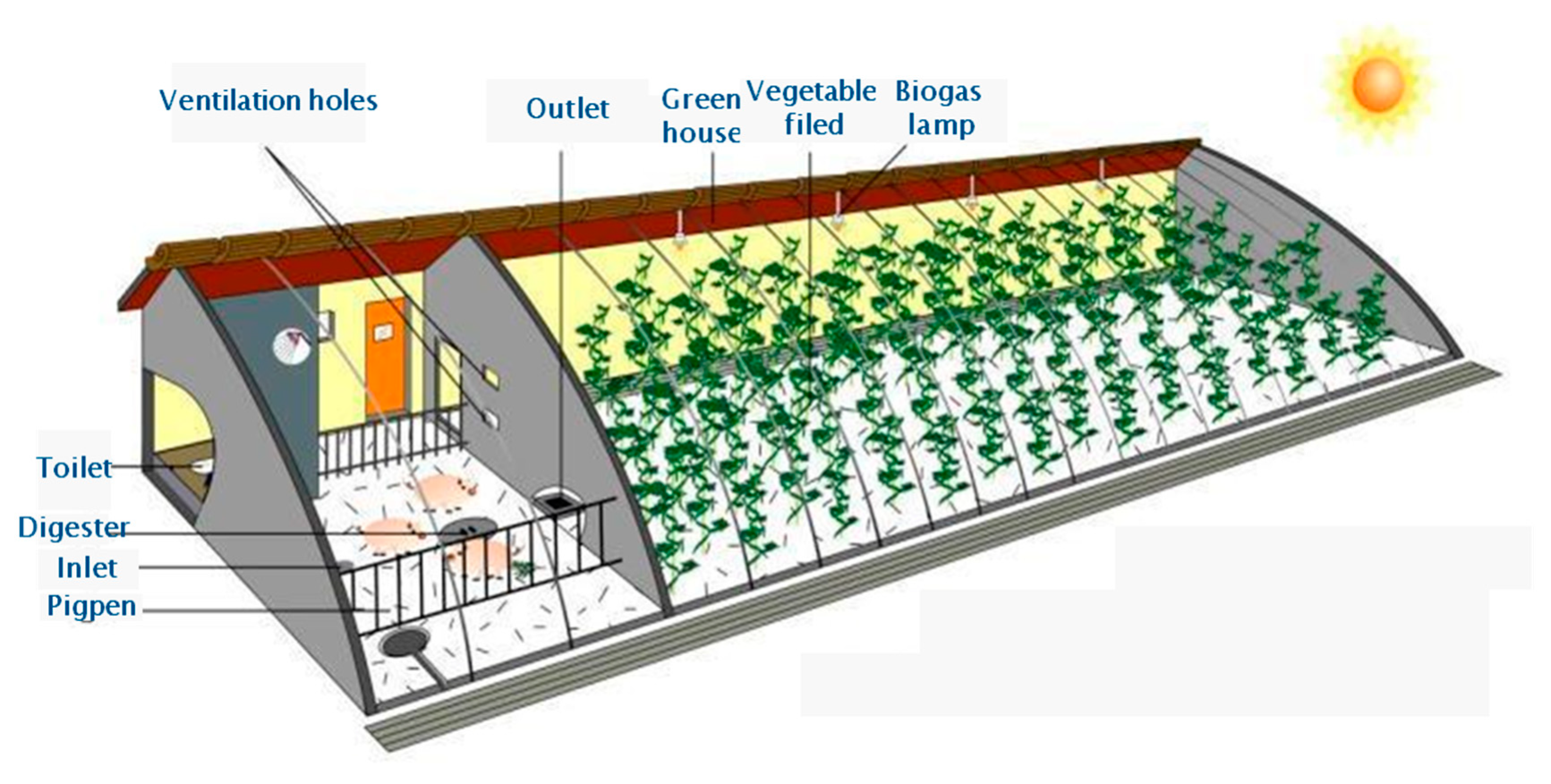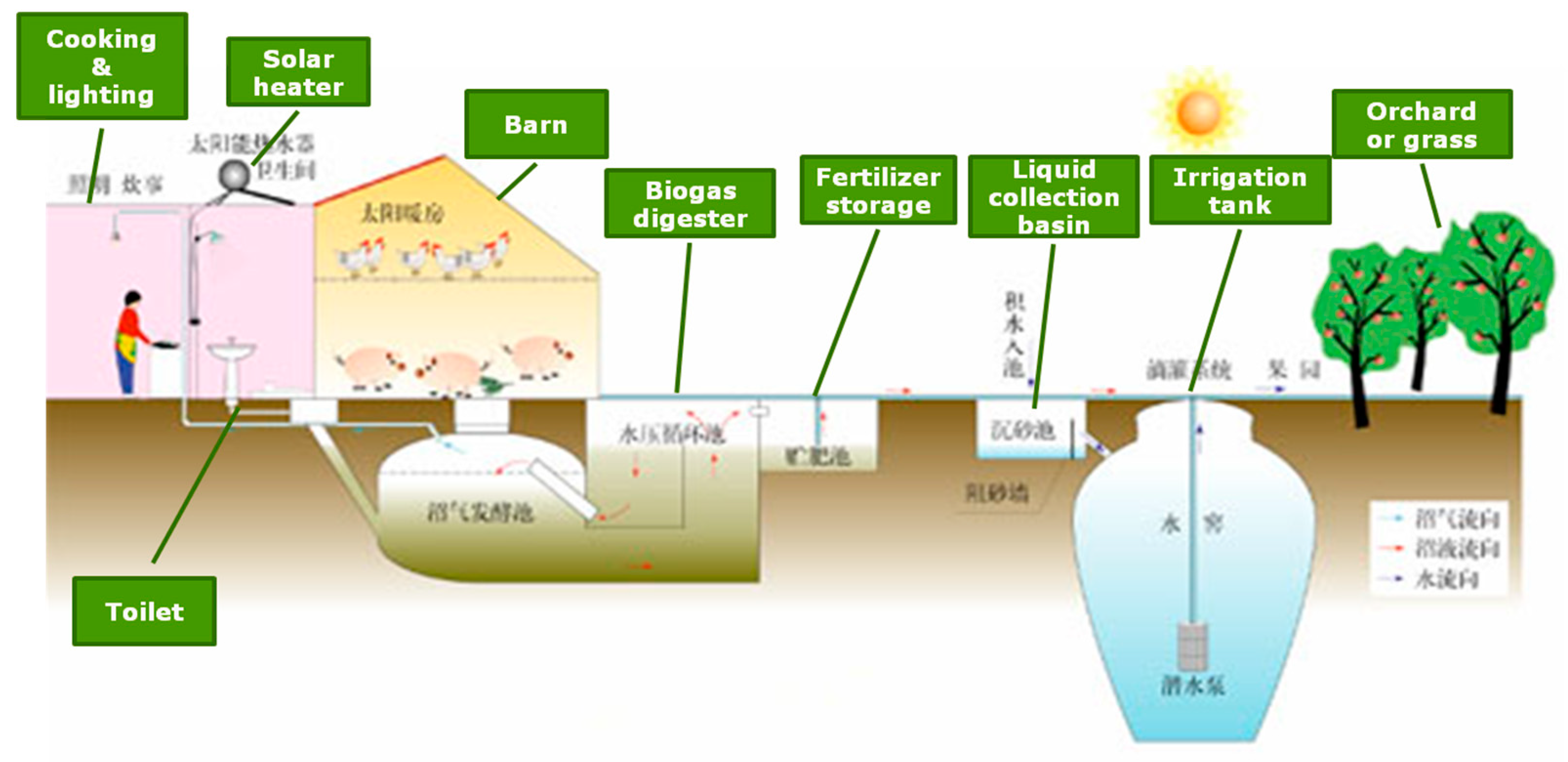1. Introduction
Waste management is a global issue and one of the essential utility services underpinning society linked directly with the public health and the environment [
1]. Biogas technology has become increasingly popular worldwide in view of the multiple benefits gained from anaerobic digestion (AD), such as alleviating energy shortage, controlling environmental pollution, reducing greenhouse gas emission, and promoting agricultural structural adjustment [
2]. AD is one of the most sustainable and promising technologies for management of organic residues [
3,
4]. Many large-scale biogas plants can be found in developed countries. Biogas is commonly used for power generation (mostly combined with heat and power) and other industrial applications or upgraded as substitute for natural gas [
5,
6]. By contrast, the technology and equipment for biogas plants are still lagging, and household biogas digesters dominate the biogas industry in developing countries. Domestic biogas technology is effectively and widely implemented in countries where governments and institutions are involved in the subsidy, planning, design, construction, operation, and maintenance of biogas plants [
7,
8]. A number of countries in Asia and Africa have launched massive campaigns to popularize biogas technology via government support and international aid (
Table 1) [
9,
10]. Globally, it is estimated that 50 million micro-digesters (family size), 132,000 biogas engineering projects (about 15,000 in Europe [
11]) and 700 biogas upgrading plants are operating [
12]. Promotion of biogas technology has several opportunities and obstacles. Numerous studies have focused on these aspects to discuss the country scenario. Many case and field studies have aimed to assess biogas technology to verify its multiple benefits [
13,
14] and identify potential barriers [
8,
15,
16,
17,
18,
19,
20,
21]. However, these studies are limited to individual country scenarios. The progress and prospect of the biogas industry in different nations vary widely. Nearly no crosswise comparisons have been made for different countries. The current study intends to fill this gap.
China leads the world in domestic biogas technology. With the expansion of the biogas industry, lessons learned, whether positive or negative, would be valuable and abundant for countries whose biogas industry is still at the initial stage, including nations mainly in South and Southeast Asia, Africa, and Latin America. Meanwhile, along with the development of medium- and large-scale biogas plants (MLBPs), progress is not trouble-free [
22]. (According to the Chinese biogas standard
NY/T 667-2011 Classification of Scale for Biogas Engineering, the thresholds of medium-scale and large-scale biogas plant are 300 m
3 and 500 m
3 for total digester volume respectively, with a minimum daily biogas production of 150 m
3 and 500 m
3 respectively. By comparison, in Germany, most biogas plants are based on farms and aim at power generation; the small biogas plant is below 150 kWel while the large biogas plant is above 500 kWel [
23] An up-to-date national surrey on German biogas plants mentioned that average installed capacity in small- to medium-scale installations on farms in the agricultural sector is ca. 500 kWel while average installed capacity in larger anaerobic AD plants is ca. 800kWel.) The development model, especially governmental subsidiaries, should be reconsidered, despite the scarcity of studies focusing on this aspect. Moreover, developed countries would accumulate experiences, and China would also benefit from these valuable lessons learned.
This study aims to provide references for the biogas industry of not only China but also other developing countries, in the hope of promoting the sound dissemination of the biogas technology in the developing world more or less.
2. Status Quo of the Biogas Industry in China
Biogas has a long history in China. The development stages are shown in
Table 2 [
31]. Since the “Rural Ecological Enrichment Project” was proposed by the Ministry of Agriculture (MOA) (MOA was renamed as Ministry of Agriculture and Rural Affairs after the governmental reshuffle in 2018) at the beginning of this century, biogas construction projects have been implemented all over the country. Support is provided via rural small-scale public infrastructure and basic construction projects, particularly since the implementation of the “National Debt Project for Rural Biogas Construction” in 2003. The biogas industry has accomplished great achievements to date.
Table 3 presents the key figures in the biogas industry of China. A new pattern has been established, i.e., different kinds of biogas plants are developed simultaneously, including domestic biogas projects, MLBPs attached to animal farms, biogas plants attached to breeding communities, biogas plants attached to primary and secondary schools, combined household biogas plants, and centralized biogas supply plants [
32].
Before 2008, the central government prioritized the domestic biogas sector. After 2009, the government has increasingly focused on MLBPs. For instance, the proportion of domestic biogas to total biogas investment decreased from 81.6% in 2008 to 47.6% in 2009, whereas that of MLBPs increased from 3% in 2008 to 35.1% in 2009 [
22]. China started to support bio-natural gas (BNG; also known as biogas upgrading or biogas-to-biomethane) projects for the first time in 2015 at the central government level. In the same year, MOA and the National Development and Reform Commission (NDRC) published a document entitled “2015 Working Plan of Upgrading and Transforming Rural Biogas Project,” which explains their aim to find a suitable area where they can build large-scale biogas projects (with daily biogas production of above 500 m
3) and implement BNG demonstration projects (where the methane content exceeds 95%; 1 m
3 biogas can usually be upgraded to 0.6 m
3 BNG) [
33]. The central government funded the building of 25 BNG demonstration projects for the first time in 2015, and this initiative was followed by the approval of 22 and 18 other BNG projects in 2016 and 2017, respectively [
34].
4. Experience for Developing Nations
Although China’s biogas industry has problems, several positive experiences could be used for reference, particularly by developing countries whose biogas industries are still in the initial stages.
4.1. Government and Policy Support
A biogas industry cannot be developed successfully without government and policy support in its initial stages [
80]. Multi-level support is essential, given that numerous developing countries implement national biogas programs. Policies are mainly implemented by legal means. The Chinese government has enacted five main laws and regulations to promote its biogas industry, including Agricultural Law, Renewable Energy Law, Animal Husbandry Law, Energy Conservation Law, and the Act on the Development of Circular Economy. The Energy Law is currently under revision. These laws explicitly aim to support the biogas industry [
81].
Economy-stimulating policies—which are known as subsidy—can be an effective means of developing the biogas industry in China. More than 42 billion CNY was subsidized by the central government between 2000 and 2017. During the biogas booming decade (2003 to 2012), approximately 91.8 billion CNY was invested into the biogas industry, 31.5 and 13.9 billion CNY of which were from the central and local governments, respectively; farmers provided the remaining 46.4 billion CNY. In 2015, the deployment of the biogas industry entered a new era. The central government stopped giving subsidy to household digesters. (However, subsidy for household digesters from local governments remains, depending on local biogas deployment strategies.) Instead, additional subsidy shifted to large-scale biogas plant and BNG demonstration projects. The subsidy standards of different types of biogas projects and service stations are presented in
Table 8.
4.2. Standard of Biogas Industry
China has established a world-renowned standard system for its biogas industry. Since the first biogas standard
Domestic Biogas Stove (GB/T 3606-83) was implemented on April 7, 1983, more than 70 biogas standards have been issued. These standards stipulate the design, construction, operation, and facility production of biogas plants and provide a strong guarantee to promote biogas industrialization. These standards cover different aspects of biogas industry, including digester design drawings, construction specification and household biogas checklist, biogas stove and accessory products, biogas project combined with agricultural production, scale classification for biogas engineering, process design, quality evaluation, construction and acceptance, safety operation, biogas power generator, biogas slurry application, and prefabricated digester. In 2011, National Biogas Standardization Technical Committee (SAC/TC 515) was established by Standardization Administration of China (SAC). Biogas Technical Committee of International Standard Organization (ISO/TC 255) was also established to provide liberalization and facilitation for international trade, develop international cooperation, curb discriminatory technical requirements, and reduce the technical barriers from international trade [
82]. China successfully applied for the chairperson and secretariat positions of ISO/TC 255.
Figure 4 presents the standard framework that has been promulgated and implemented in the country [
83].
In numerous developing countries, standard systems are incomplete or even non-existent. Several countries adopted biogas standards from China, such as Vietnam and Bangladesh, and gradually set up corresponding standard systems in accordance with local conditions. For instance, the dissemination model of a digester structure greatly varies in different nations. Even if digester design have been standardized in numerous countries, a comprehensive standard problem should be developed as well. Biogas appliances, pipe connection materials and fittings, O and M of biogas plant, digestate application, and other socioeconomic aspects should also be standardized, to realize the full lifecycle control and management.
4.3. Application of Prefabricated Digesters
Since the 1980s, China has developed numerous kinds of commercialized or half-commercialized domestic biogas digesters to overcome the weaknesses of traditional brick and concrete household digesters. Contrary to onsite-constructed digesters (OCD), a prefabricated biogas digester (PBD) is produced offsite by using materials with special physical properties. In China, prefabricated digesters are often called “commercialized digesters”; these digesters are also called the “three new digesters,” as new production materials, processes, and techniques are usually adopted [
84].
Table 9 presents a comparison of PBDs and OCDs.
The most common PBDs in China are plastic soft digesters (PSDs) and composite material digesters (CMDs). PSDs are also known as bag digesters (BDs) worldwide and include the plastic tubular digester used in Latin America [
85,
86]. BDs are the most popular PBDs; they have been widely applied successfully because of their low cost and easy implementation and handling. BD digesters have also been proved to be an appropriate and environmentally friendly technology at high altitude [
87]. A BD consists of a long cylinder made of polyvinyl chloride, polyethylene, or red mud plastic. Meanwhile, CMDs originated from China. These new digesters offer many advantages, such as easy mobility, long-term durability, and high productivity. Fiberglass-reinforced plastic (FRP) digesters are a common representative of CMDs. Raw materials of FRP digesters comprise unsaturated polyester, gel-coated resin, chopped strand mat, and high-quality glass fiber cloth. The inner surface of the FRP digester is painted with a gel-coated resin to ensure tightness. CMDs are relatively new in countries such as Bangladesh, Cambodia, Nepal, Vietnam, and particularly African countries. Most CMD models are introduced and modified locally [
88].
Since 2000, PBDs have entered the real commercial stage, and several manufacturers have emerged in the industrial scene. At present, several industrial standards for PBDs are in place, such as NY/T 1699-2009 Technical Specifications for Household Anaerobic Digesters of Fiberglass Reinforced Plastic, NY/T 2910-2016 Rigid plastics household biogas digester, QB/T 5260-2018 Reprocessed plastic assembled biogas digester.
Other types of PBDs are also applied in China, among which portable and onsite-assembled digesters are promising. These digesters are dismountable units mainly used to treat green and kitchen wastes. A plug-and-play method of applying AD technology is provided by this type of digester. Besides, China has also applied CMDs in prefabricated wastewater treatment systems [
89].
Several countries implement national biogas programs and also investigate PBDs, including Nepal, Bangladesh, Vietnam, and Myanmar. Initial models are mostly imported from China because factory production of PBDs is non-existent in other developing countries; the quality of locally produced PBDs is relatively low. International trade and cooperation could establish new markets for the PBD industry in China and biogas industry in other countries. China exports large numbers of PBDs, thereby making these products accessible to local users. Therefore, additional product marketing activities from local suppliers and distributors are necessary to increase the number of people who are aware of the product and the number of potential customers. The PBD industry requires substantial effort to become highly prominent in developing countries. An increased demand for PBDs in the future is expected in other developing countries.
4.4. Biogas-Linked Agricultural Models
Biogas construction projects have been implemented all over China since the “Rural Ecological Enrichment Project” was proposed by the MOA. A good model combining biogas digester with agricultural production has been developed. Several models have also been established, including 3-in-1 [
36], 4-in-1 [
37,
90], and 5-in-1 models [
91] (
Figure 5,
Figure 6, and
Figure 7). An overview of these models is shown in
Table 10. These models would be copied and applied in other countries as examples. For instance, Mongolia shares a similar climate with Northeast China, numerous African countries with Northwest China, and Southeast Asian countries with South China. These models would be valuable and reproducible technologies adopted from China.
5. Conclusions and Outlook
Due to the production of methane rich energy and recycling of nutrients, biogas technology through AD is one of the most promising technologies for management of organic waste. China’s biogas industry was reconsidered and re-appraised. Unlike Europe, China currently uses underdeveloped equipment and technology. Furthermore, the subsidy system is inflexible, co-digestion application is in its initial stages, biogas upgrading technology is immature, and planning and management of digestate is insufficient. Moreover, subsidy should be based on products (i.e., output-oriented) instead of construction costs. Nevertheless, China’s biogas industry shows several positive features that can be considered by other developing countries. These positive features include relatively complete laws, policies and subsidy system, world-renowned standard system, well-developed prefabricated biogas industry, and efficient biogas-linked agricultural models.
Whether it is in China or in other developing countries, the future of the biogas industry is projected to be marketized. An integrated whole industry chain should be explored, including collection and storage of feedstocks, O and M of plant, and sale and utilization of end products. A number of demonstration projects should be built to innovate project construction and operation mechanism. On one hand, the specialized enterprises, rather than the government, should be treated as the main bodies of the industry chain. They can invest, operation or sell the project in accordance with the market mechanism. On the other hand, the government, which plays an assistant role, could provide output subsidies to project owners, according to production/sale capacity of biogas/biomethane, utilization capacity of digestate or processed capacity of organic fertilizer from digestate. Last but not least, China is a big country with quite different situations due to the large latitude range and the complex topography. Some factors affecting the deployment of a biogas project include the availability of feedstocks, the stability of local policy, the willingness to use biogas/biomethane and bio-fertilizer, the participation of stakeholders, etc. Regional differentiation had been taken into consideration when the government developed the subsidy system before 2015. Nevertheless, the upgrading policy from the central government in 2015 only subsidized the large-scale biogas plants and BNG projects without considering household digesters and small/medium-scale biogas plants anymore. Due to regional differentiation, some poor areas still could develop household digester or distributed small/medium-scale biogas plants for local energy supply, even if the percentage is smaller. In such cases, local government should take over the critical role and continue to support them.
The innovation in biogas equipment and technology is lagging as a result of the malfunction between research and industry. Actually, many technologies and equipment suppliers from developed countries such as Germany, Austria, Sweden, France, Italy, etc., can be found in China. Proven technologies, such as garage-type dry fermentation and plug-flow dry fermentation, are feasible and promising especially for municipal solid organic wastes and agricultural straw. However, further research and technological improvements are required to improve the flexibility, adaptability, and efficiency of a dry fermentation biogas plant. China should R&D biogas equipment and technology with self-relied intellectual property, rather than only copy from other countries.
The function of the biogas plant should be reconsidered. Before, the construction of a biogas plant aimed to alleviate energy shortage and agricultural pollution. At present, under the background of the circular economy, biogas should be integrated into energy supply-side reform, modern agriculture, resource utilization, and environmental protection. Plenty of biogas plants were abandoned as a result of technical, institutional and socio-cultural barriers. Actually, we do not need to build more biogas plants if the abandoned plants can be revived. If agricultural residues and animal manure are not sufficient, is alternative substrate available, for instance, kitchen waste or human waste? Doubtlessly, the revival of abandoned biogas plants could save resources and be beneficial to sound development of the Chinese biogas industry, towards building a conservation-minded society
